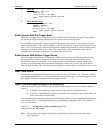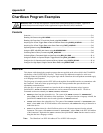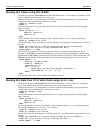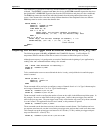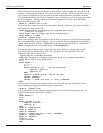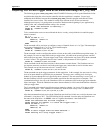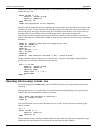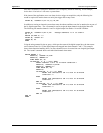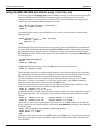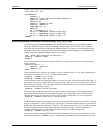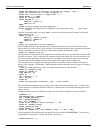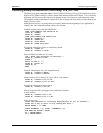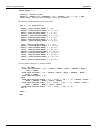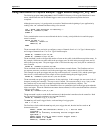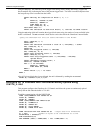
Appendix D ChartScan Program Examples
ChartScan User’s Manual D-7
After the C command is issued, the ChartScan is now completely armed for alarming. In our example,
levels above 18 or below 1 will cause a system alarm.
If the intent of the application was to use alarm levels to trigger an acquisition, only the following line
would be required to arm the alarms to satisfy the trigger and/or stop events.
PRINT #1, “OUTPUT 07;C1-16,3,1,18,0X”
In addition to causing an internal system alarm state, the alarm conditions can also be attached to any one of
the 16 digital output lines. The A command is used to assign the input channels to the digital alarm bit.
The following line attaches channels 1 and 2 to digital output line number 1 in an OR’d fashion.
PRINT #1, “OUTPUT 07;A1-2,1X” ‘Assign channels 1 & 2 to alarm 1
S% = 0
WHILE (S% AND 4) = 0
PRINT #1, “SPOLL 07"
INPUT #2, S%
WEND
Using the string returned by the O? query, which gets the status of the digital output lines, the alarm state
can be detected since bit 1 of the digital output was mapped into alarm channel 1 and 2. This example
shows alarm detection handling when 2 or more channels have to be muxed into one single digital output
bit. The “
U11X” command shows each individual channel alarm status.
WHILE INKEY$ = “”
PRINT #1, “OUTPUT 07;O?X”
PRINT #1, “ENTER 07"
LINE INPUT #2, O$
IF MID$(O$, 2, 3) = “001" THEN
PRINT “Channel 1 OR 2 is in Alarm condition.”
PRINT #1, “OUTPUT 07;U11X”
PRINT #1, “ENTER 07"
LINE INPUT #2, A$
PRINT A$
IF MID$(A$, 5, 1) = “1" THEN
PRINT “The ChartScan’s CH 1 is now in an Alarm
condition..”:
ELSE
PRINT “The ChartScan’s CH 1 is not in an Alarm
condition..”
END IF
IF MID$(A$, 11, 1) = “1" THEN
PRINT “The ChartScan’s CH 2 is now in an Alarm
condition..”:
ELSE
PRINT “The ChartScan’s CH 2 is not in an Alarm
condition..”
END IF
END IF
WEND



